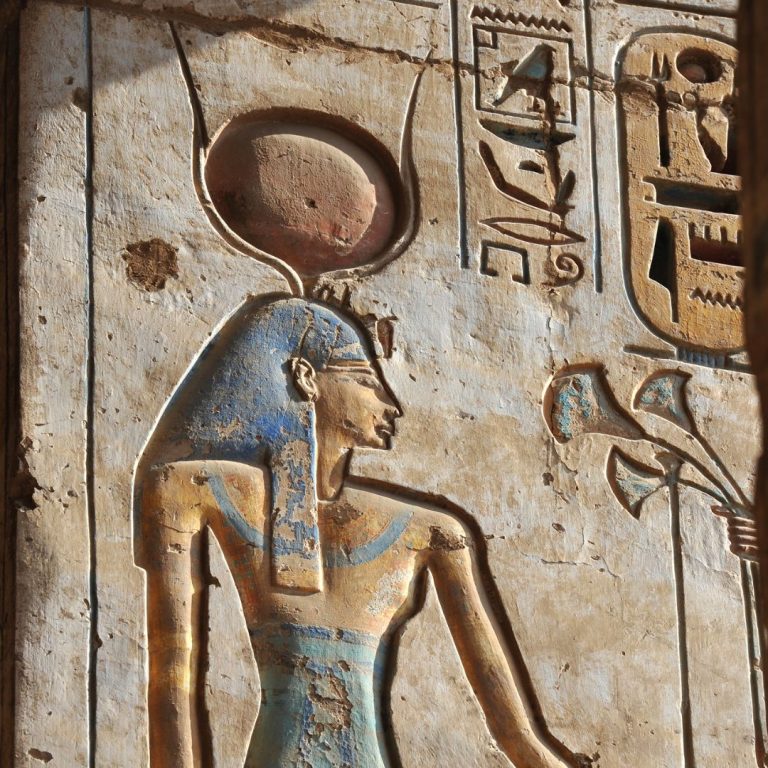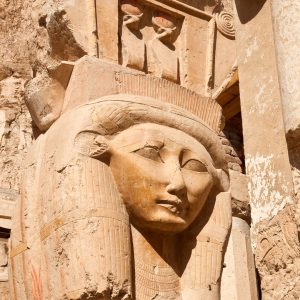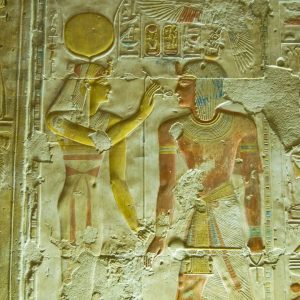

Home » Weekly Blog » Hathor: The Joyful Goddess of Ancient Egypt
The tapestry of Egyptian mythology is adorned with a multitude of gods and goddesses, each with their own unique qualities and significance. Among these divine figures, Hathor stands out as a symbol of joy, love, music, and dance. She is a beloved deity whose presence graced the lives of ancient Egyptians and continues to captivate the modern world with her timeless allure.
Hathor’s name itself carries a certain mystique, which is often translated as “House of Horus.” This alludes to her connection with Horus, the powerful and revered sky god. However, Hathor’s identity stretches far beyond this association. She is a goddess of multiple facets, an embodiment of joy, motherhood, and divine femininity.
In this exploration of Hathor, we will delve into the depths of her history, attributes, and roles within Egyptian mythology. We will uncover the symbols that define her, the festivals dedicated to her, and her enduring legacy that extends well beyond the banks of the Nile. Join us on this journey through the rich tapestry of Egyptian mythology as we discover the radiant and joyful goddess, Hathor.

Hathor’s origins are deeply rooted in the annals of ancient Egyptian history, stretching back thousands of years. As we unravel the story of this captivating goddess, we find a narrative that intertwines with the very essence of Egyptian culture and belief.
Hathor’s presence can be traced to the earliest dynasties of Egypt, where she evolved from a local deity into a widely venerated goddess. Her origins are often linked to the predynastic period, and she gradually assimilated characteristics of other goddesses, creating a composite figure of great significance. It’s believed that her worship began in the region of Dendera, and from there, it expanded across the entire country.
Her early forms included the Cow Goddess and the Sky Goddess, both of which played vital roles in ancient Egyptian cosmology. The cow, representing fertility and nurturing, served as a powerful symbol that was eventually incorporated into Hathor’s iconography.
As time passed, Hathor became associated with the nurturing and protective aspects of motherhood, which aligned with her image as a cow. Her transformation into the goddess of music, dance, and joy also took shape over centuries. Hathor’s evolution in Egyptian mythology mirrors the evolving cultural and religious landscape of the ancient civilization.
Hathor’s rise to prominence was not just a matter of religious evolution; it was also influenced by her role as the “Mistress of Dendera,” a title that reinforced her significance. This divine association with a specific place, the temple of Dendera, solidified her importance in the Egyptian pantheon.
In the following sections of this blog post, we will delve deeper into Hathor’s attributes, her many roles, and her enduring influence on the people of ancient Egypt and beyond. Through the lens of Hathor’s evolution, we gain insight into the rich and complex tapestry of Egyptian mythology.
Hathor is a goddess of immense symbolism and significance in the pantheon of Egyptian deities. Her attributes and symbols are not only visually striking but also laden with profound meaning, shedding light on the various aspects of her divine persona.
1. The Cow Horns and Sun Disk: One of Hathor’s most recognizable symbols is her headdress, consisting of a pair of curved cow horns cradling a radiant sun disk. This iconic representation reflects her ancient connection to the cow, symbolizing motherhood, nurturing, and fertility. The sun disk signifies her role as a solar goddess, connecting her to the life-giving power of the sun. Hathor’s influence extended to the realm of agriculture, as she was often invoked to ensure the fertility of the land and the success of crops.
2. The Sistrum: Hathor is frequently depicted holding a musical instrument known as a sistrum. This rattling percussion instrument, resembling a metal hoop with metal rods, is associated with her role as a goddess of music, dance, and joy. The sistrum’s melodious sound was believed to invoke Hathor’s divine presence and bring happiness to the lives of her worshippers. It played a central role in many religious ceremonies and festivals dedicated to the goddess.
3. The Ankh: Often seen with an ankh, the Egyptian symbol for life, Hathor’s connection to fertility, rebirth, and the cycle of life is emphasized. The ankh is a cross with a loop at the top, signifying the eternal nature of life and the afterlife. It underscores Hathor’s role in guiding souls to the realm of the dead and her association with the goddess of the afterlife, Isis.
4. Lotus Flower: Hathor is sometimes portrayed with a lotus flower in her hand, symbolizing rebirth and creation. The lotus has deep-rooted cultural and spiritual significance in Egypt and represents the emergence of life from the primordial waters. Hathor’s connection with the lotus emphasizes her role in bringing forth life and renewal.
These symbols not only define Hathor’s character but also offer a window into the cultural and religious beliefs of ancient Egypt. They underscore her multi-faceted nature, encompassing fertility, music, dance, and the interconnectedness of life and death. In the following sections of this blog post, we will explore how Hathor’s attributes were integrated into various aspects of ancient Egyptian culture and religious practices.

Hathor, the goddess of myriad talents and qualities, plays a diverse range of roles in Egyptian mythology, making her a beloved and complex figure in the pantheon. Let’s delve into these roles and uncover the multifaceted nature of Hathor:
1. Goddess of Love and Beauty: Hathor is often celebrated as the goddess of love, beauty, and sensuality. Her radiant and nurturing qualities, symbolized by the cow’s imagery, earned her a place as the embodiment of feminine allure. She was invoked for blessings in matters of love, relationships, and physical beauty. Hathor’s benevolent presence was believed to bring happiness and harmony into the lives of her devotees.
2. Goddess of Music and Dance: Hathor’s association with music and dance is a testament to her joyful and celebratory nature. She was revered as the patroness of musicians, dancers, and artists, and her sistrum, an instrument used in her worship, created melodious sounds that were thought to bring about happiness and merriment. Festivals dedicated to Hathor often featured music, dance, and revelry, making her a central figure in joyous celebrations.
3. Protector of Mothers and Children: Hathor’s nurturing aspects extend to her role as a protector of mothers and their children. She was often invoked during childbirth and early childhood to ensure the well-being and health of both mother and child. Her gentle and caring nature offered solace to women in times of vulnerability, emphasizing her importance in the lives of Egyptian families.
4. Goddess of Fertility: Hathor’s cow symbolism is closely associated with fertility and agricultural abundance. As the “Mistress of Heaven,” she was believed to nurture the land, ensuring bountiful harvests and the well-being of livestock. Farmers and agricultural communities looked to Hathor for her blessings to guarantee their prosperity.
5. Guide to the Afterlife: Hathor also had a significant role in the realm of the dead. She was often associated with the goddess Isis, assisting in the journey to the afterlife. Together, they provided comfort and guidance to the deceased, ensuring a safe passage into the underworld.
These various roles highlight the versatility of Hathor in Egyptian mythology, and they mirror the interconnected aspects of life and spirituality in the ancient Egyptian worldview. Hathor’s worship and influence were pervasive in the daily lives of the people, reflecting the importance of joy, love, and nurturing in their culture. In the subsequent sections of this blog post, we will explore Hathor’s representation in art, festivals dedicated to her, and her lasting impact on Egyptian culture and beyond.
Hathor’s enchanting presence is vividly captured in the art and iconography of ancient Egypt, offering us a visual journey into her significance and influence. Her depictions in various forms and contexts reveal the enduring impact she had on Egyptian culture and religion:
1. Iconic Representations: In Egyptian art, Hathor is commonly portrayed as a woman with the distinctive headdress consisting of cow horns and a sun disk. This headdress often features a uraeus, a symbol of protection, reinforcing her role as a guardian deity. She is typically depicted with a graceful and nurturing demeanor, embodying the qualities of a loving mother and a benevolent goddess.
2. Temples and Shrines: Hathor’s influence is palpable in the architecture and decorations of Egyptian temples and shrines dedicated to her. One of the most renowned temples is the Temple of Hathor at Dendera, located in Upper Egypt. This temple is adorned with intricate carvings, paintings, and inscriptions that celebrate the goddess. The inner sanctuary of the temple is a sacred space where her presence was believed to reside.
3. Hathor’s Sistrum: As the goddess of music and dance, Hathor’s sistrum is a prominent symbol that is often represented in Egyptian art. This musical instrument is intricately decorated with images of Hathor herself, emphasizing her connection to music and joy. The sistrum played a central role in religious ceremonies and rituals dedicated to the goddess.
4. Hieroglyphs and Inscriptions: Hathor’s name and symbols frequently appear in hieroglyphic inscriptions throughout ancient Egyptian history. These inscriptions are found on temples, tombs, and artifacts, indicating her enduring presence in the religious and cultural landscape of Egypt.
5. Jewelry and Personal Items: Hathor’s image was not limited to temples and public spaces. Her influence extended to personal belongings and jewelry worn by the ancient Egyptians. Amulets, bracelets, and other adornments featuring Hathor’s likeness were believed to bring protection, joy, and blessings to the wearer.
The rich tapestry of art and iconography surrounding Hathor showcases the profound impact she had on Egyptian society. Her imagery and symbolism were woven into the fabric of daily life, providing comfort, guidance, and a source of joy to the people. The next sections of this blog post will further explore the festivals dedicated to Hathor and her far-reaching influence on the ancient world, extending beyond the borders of Egypt.
Hathor’s influence transcended the realm of symbolism and mythology, extending into the vibrant and celebratory festivals dedicated to her. These festive occasions were central to Egyptian culture and played a significant role in honoring the goddess, fostering community spirit, and invoking her blessings. Here, we delve into some of the major festivals and celebrations dedicated to Hathor:
1. The Feast of Hathor: The Feast of Hathor was one of the most eagerly anticipated events in the Egyptian calendar. Celebrated annually, this festival was a time of joy, music, and dance. Devotees would gather in temples, especially at Dendera, to honor Hathor and seek her blessings. Musicians and dancers performed to the accompaniment of the sistrum, filling the air with the melodies believed to invoke Hathor’s divine presence. It was a time of revelry, unity, and expressing gratitude for Hathor’s benevolence.
2. The Beautiful Feast of the Valley: Another significant celebration associated with Hathor was the “Beautiful Feast of the Valley.” During this event, statues of various deities, including Hathor, were transported from their temples to visit the mortuary temples of deceased pharaohs on the west bank of the Nile. This festival served as a commemoration of the connection between the living and the deceased and was marked by processions, offerings, and festivities.
3. Hathoric Processions: Throughout the year, processions in honor of Hathor would take place in various cities across Egypt. These processions typically involved carrying images or statues of the goddess through the streets, accompanied by music and dance. It was a way for the community to come together, express their devotion, and seek Hathor’s blessings for their city and its people.
4. The Hathoric New Year: The Hathoric New Year, which marked the beginning of the agricultural season, was celebrated in her honor. It was a time when farmers looked to Hathor to ensure a successful harvest. The festival included rituals and offerings to the goddess to secure her favor for a prosperous year ahead.
These festivals and celebrations weren’t just occasions for merrymaking; they played an essential role in the religious and cultural life of ancient Egypt. The rituals, music, and dance were believed to connect the mortal realm with the divine, fostering a sense of unity and harmony within the community. Hathor’s festivals continue to be celebrated and reimagined in modern times, showcasing the enduring legacy of this beloved goddess.
In the subsequent sections of this blog post, we will explore Hathor’s influence beyond the borders of Egypt and her lasting impact on neighboring regions and ancient civilizations.
The allure and influence of Hathor were not confined to the banks of the Nile; her worship extended beyond Egypt’s borders, leaving an indelible mark on neighboring regions and ancient civilizations. Here, we explore Hathor’s reach and how her appeal transcended cultural boundaries:
1. Nubia (Ancient Sudan): Hathor’s influence was notably strong in Nubia, an ancient region that corresponds to present-day Sudan and southern Egypt. Temples dedicated to Hathor can be found in Nubian archaeological sites, indicating the goddess’s veneration in this region. Nubian rulers often incorporated Hathor’s imagery and symbolism into their own religious and political iconography, reflecting her importance.
2. Sinai Peninsula: Hathor was revered in the Sinai Peninsula, a region known for its turquoise mines. The goddess was associated with mining activities, as turquoise was considered a sacred stone in Egyptian culture. Miners sought Hathor’s protection and blessings as they extracted the precious gemstone from the earth.
3. Canaan and the Levant: Hathor’s influence extended into Canaan and the Levant, regions that are now part of modern-day Israel, Palestine, and Lebanon. Hathor was sometimes incorporated into the pantheons of Canaanite and Levantine cultures, highlighting her appeal beyond the borders of Egypt.
4. Trade and Cultural Exchange: Egypt’s extensive trade networks allowed for the dissemination of Hathor’s influence to distant lands. As trade routes crisscrossed the ancient world, Hathor’s symbols and attributes likely played a role in shaping the religious beliefs and artistic expressions of cultures encountered along these routes.
Hathor’s appeal lay in her roles as a goddess of joy, love, and nurturing, which resonated with people across diverse cultures and regions. Her symbols and iconography, such as the cow horns and sistrum, were recognized and revered beyond Egypt, leaving traces in the artistic and religious traditions of neighboring societies.
As we delve deeper into Hathor’s legacy in the final sections of this blog post, we will explore how her timeless influence continues to captivate and inspire people in the modern world, underscoring her enduring significance across the ages.

Hathor’s legacy is a testament to her enduring appeal and timeless relevance. The goddess of joy, love, and nurturing continues to captivate the imaginations of people, transcending millennia to remain a subject of fascination and admiration. Here, we explore the lasting impact of Hathor on art, culture, and spirituality in the modern world:
1. Contemporary Art and Pop Culture: Hathor’s iconic imagery continues to inspire artists and creators around the world. Her distinctive headdress, the cow horns and sun disk, can be seen in various artistic expressions, from paintings and sculptures to fashion and design. She has made her way into contemporary pop culture, appearing in movies, video games, and literature, where her character embodies elements of grace and divine femininity.
2. Revived Worship and Spiritual Practices: In recent years, there has been a resurgence of interest in ancient Egyptian spirituality and goddess worship. Hathor, with her qualities of love, beauty, and celebration, has found a place in modern spiritual practices and rituals. Some individuals and groups have incorporated her into their belief systems, recognizing her as a symbol of empowerment, creativity, and joy.
3. Celebrating Feminine Strength: Hathor’s legacy continues to serve as a source of inspiration for those who celebrate feminine strength and nurturing qualities. Her image has been embraced as a symbol of female empowerment and the enduring power of the divine feminine in a world that often demands recognition and respect for women’s contributions.
4. Music and Dance: Hathor’s association with music and dance lives on through various art forms. Musicians and dancers draw inspiration from her joyful and celebratory nature, infusing their performances with elements of her spirit. Her sistrum, the musical instrument symbolizing her, is still occasionally used in contemporary music, underscoring her enduring influence.
5. Universal Themes: Beyond her role in Egyptian mythology, Hathor embodies universal themes of joy, love, and the interconnectedness of life. Her legacy reminds us of the human need for celebration, nurturing, and the acknowledgment of the beauty and grace in the world around us.
Hathor’s timeless appeal lies in her capacity to evoke emotions and ideals that resonate with people across cultures and eras. Her legacy continues to inspire, celebrating the enduring influence of a goddess whose essence embodies the joys and beauties of life.
In conclusion, Hathor remains an enchanting figure who, even in the modern world, reminds us of the enduring significance of love, music, and the celebration of life’s abundant beauty. Her story endures as a testament to the timeless appeal of ancient mythology and the powerful influence it can exert on our understanding of the world and our place within it.
In the vast pantheon of ancient Egyptian deities, Hathor, the goddess of joy, love, music, and dance, stands as a luminous figure whose influence has transcended the boundaries of time and geography. As we conclude our exploration of Hathor, we are reminded of the enduring impact she has had on the realms of mythology, art, culture, and spirituality.
Hathor’s origin story, evolution, and diverse roles in Egyptian mythology reveal a complex, multifaceted goddess who embodied the nurturing qualities of a mother, the joy of music and dance, and the power of love. Her attributes, symbolized by the iconic cow horns, sun disk, and sistrum, have left an indelible mark on ancient Egyptian art and iconography.
The festivals and celebrations dedicated to Hathor, such as the Feast of Hathor and the Beautiful Feast of the Valley, served as vibrant expressions of devotion, community unity, and a celebration of life. These events brought people together to honor the goddess and invoke her blessings, fostering a profound connection between the mortal realm and the divine.
Hathor’s influence extended far beyond the borders of Egypt, leaving her mark on regions as distant as Nubia, the Sinai Peninsula, and the Levant. Her symbols and attributes were recognized and revered by neighboring cultures, illustrating the universality of her appeal.
Today, Hathor’s legacy endures in contemporary art, spirituality, and pop culture. Her image continues to inspire artists and creators, while her qualities of joy, love, and nurturing resonate with those who seek empowerment and connection with the divine feminine.
In closing, Hathor’s story is a testament to the timeless allure of ancient mythology and the enduring power of symbols and ideals that celebrate the joys and beauty of life. The goddess Hathor continues to cast her radiant light across the ages, reminding us of the eternal qualities that make life worth celebrating, cherishing, and sharing with one another.
Sign up to hear about our upcoming adventures, monthly newsletter, exclusive offers, and more!
Required*
Not Ready to book?
Get regular updates on upcoming tour and special promotions.







Sign up for our Mailing List to get updates on our current offerings.

We look forward to seeing you on one of our tours!